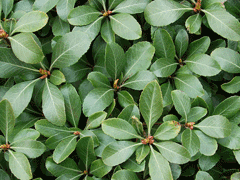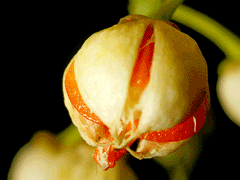 |
|
http://commons.wikimedia.org/wiki/User:Loadmaster |
 |
| http://commons.wikimedia.org/wiki/User:AlexanderKlink |
Translate this page:
Summary
Bloom Color: Green, White. Main
Bloom Time: Early summer, Late summer, Mid summer. Form: Prostrate, Spreading or horizontal, Variable spread.
Physical Characteristics

 Euonymus fortunei is an evergreen Climber growing to 4.5 m (14ft) by 10 m (32ft) at a medium rate.
Euonymus fortunei is an evergreen Climber growing to 4.5 m (14ft) by 10 m (32ft) at a medium rate.
See above for USDA hardiness. It is hardy to UK zone 5. It is in leaf all year, in flower in July. The species is hermaphrodite (has both male and female organs) and is pollinated by Insects.
Suitable for: light (sandy), medium (loamy) and heavy (clay) soils and can grow in heavy clay soil. Suitable pH: mildly acid, neutral and basic (mildly alkaline) soils. It can grow in full shade (deep woodland) semi-shade (light woodland) or no shade. It prefers dry or moist soil.
UK Hardiness Map
US Hardiness Map
Synonyms
E. radicans.
Plant Habitats
Woodland Garden Dappled Shade; Shady Edge; not Deep Shade; Ground Cover; Hedge; North Wall. By. East Wall. By. South Wall. By. West Wall. By.
Edible Uses
References More on Edible Uses
Medicinal Uses
Plants For A Future can not take any responsibility for any adverse effects from the use of plants. Always seek advice from a professional before using a plant medicinally.
Cancer Women's complaints
Plants contain the anticancer compound dulcitol[218]. The plant is used in gynaecological applications[218].
References More on Medicinal Uses
The Bookshop: Edible Plant Books
Our Latest books on Perennial Plants For Food Forests and Permaculture Gardens in paperback or digital formats.

Edible Tropical Plants
Food Forest Plants for Hotter Conditions: 250+ Plants For Tropical Food Forests & Permaculture Gardens.
More

Edible Temperate Plants
Plants for Your Food Forest: 500 Plants for Temperate Food Forests & Permaculture Gardens.
More

More Books
PFAF have eight books available in paperback and digital formats. Browse the shop for more information.
Shop Now
Other Uses
Hedge Hedge
A good evergreen ground cover plant[184, 200]. The sub species E. fortunei radicans and E. fortunei carrieri are particularly useful, other forms to use include 'Emerald and Gold', 'Emerald Gaiety', 'Coloratus', 'Dart's Carpet' and 'Kewensis[182, 188, 197]. Plants can be grown as a low hedge[29], the varieties 'Emerald and Gold' and 'Variegatus' are normally used. They are very tolerant of clipping[200].
Special Uses
Ground cover Hedge Hedge
References More on Other Uses
Cultivation details
Landscape Uses:Container, Erosion control, Ground cover, Massing. Thrives in almost any soil, including chalk, and is particularly suited to dry shaded areas[200]. Grows well in heavy clay soils. Prefers a well-drained loamy soil. Thrives in sunny positions and in deep shade[11, 182], though it does not fruit so well in the shade. Plants are hardy to about -18°c[202]. A shrubby somewhat creeping plant that can also climb by means of aerial roots[184], if placed by a support, a wall, tree or fence, the plant will start to climb it and will be self-attaching to a large degree[182, 219]. Plants do not normally require pruning[219]. Plants have two forms of growth, a juvenile form and a mature form when the plants come into flower[219]. Plants in Britain often retain the juvenile form and never flower[219]. A polymorphic species[58], there are a number of named varieties selected for their ornamental value[182, 202]. Special Features:Not North American native, Invasive, Inconspicuous flowers or blooms.
References Carbon Farming Information and Carbon Sequestration Information
Temperature Converter
Type a value in the Celsius field to convert the value to Fahrenheit:
Fahrenheit:
The PFAF Bookshop
Plants For A Future have a number of books available in paperback and digital form. Book titles include Edible Plants, Edible Perennials, Edible Trees,Edible Shrubs, Woodland Gardening, and Temperate Food Forest Plants. Our new book is Food Forest Plants For Hotter Conditions (Tropical and Sub-Tropical).
Shop Now
Plant Propagation
Seed - best sown as soon as it is ripe in a cold frame. Stored seed requires 8 - 12 weeks warm followed by 8 - 16 weeks cold stratification and can then be sown in a cold frame[78, 98]. When they are large enough to handle, prick the seedlings out into individual pots and grow them on in the greenhouse for at least their first winter. Plant them out into their permanent positions in late spring or early summer, after the last expected frosts. Cuttings of half-ripe wood, 5 - 8cm long taken at a node or with a heel, July/August in a frame. Very easy[200].
Other Names
If available other names are mentioned here
Native Range
TEMPERATE ASIA: China (Anhui Sheng, Fujian Sheng, Gansu Sheng, Guangdong Sheng, Guangxi Zhuangzu Zizhiqu, Guizhou Sheng, Hainan Sheng, Hebei Sheng, Henan Sheng, Hubei Sheng, Hunan Sheng, Jiangsu Sheng (c. & w.), Jiangxi Sheng, Liaoning Sheng, Qinghai Sheng, Shaanxi Sheng, Shandong Sheng, Shanxi Sheng, Sichuan Sheng, Xinjiang Uygur Zizhiqu, Yunnan Sheng, Zhejiang Sheng), Korea, Japan (Hokkaidô, Honshu, Kyushu, Ryukyu Islands, Shikoku) TROPICAL ASIA: India, Laos, Myanmar, Thailand, Vietnam, Indonesia, Philippines
Weed Potential
Right plant wrong place. We are currently updating this section.
Please note that a plant may be invasive in one area but may not in your area so it's worth checking.
Conservation Status
IUCN Red List of Threatened Plants Status :

Growth: S = slow M = medium F = fast. Soil: L = light (sandy) M = medium H = heavy (clay). pH: A = acid N = neutral B = basic (alkaline). Shade: F = full shade S = semi-shade N = no shade. Moisture: D = dry M = Moist We = wet Wa = water.
Now available:
Food Forest Plants for Mediterranean Conditions
350+ Perennial Plants For Mediterranean and Drier Food Forests and Permaculture Gardens.
[Paperback and eBook]
This is the third in Plants For A Future's series of plant guides for food forests tailored to
specific climate zones. Following volumes on temperate and tropical ecosystems, this book focuses
on species suited to Mediterranean conditions—regions with hot, dry summers and cool, wet winters,
often facing the added challenge of climate change.
Read More
Expert comment
Author
(Turcz.)Hand-Mazz.
Botanical References
1158200
Links / References
For a list of references used on this page please go here
Readers comment
© 2010, Plants For A Future. Plants For A Future is a charitable company limited by guarantee, registered in England and Wales. Charity No. 1057719, Company No. 3204567.